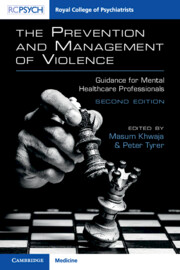Book contents
- The Prevention and Management of Violence
- The Prevention and Management of Violence
- Copyright page
- Dedication
- Contents
- Contributors
- Preface
- Abbreviations
- Section 1 General Aspects of Management
- Section 2 Medical and Psychological Intervention
- Section 3 Violence in Different Settings
- Section 4 Management in Other Groups
- Section 5 Violence and Society
- Introduction to Section 5
- Chapter 17 Criminal and Youth Justice Liaison and Diversion Systems
- Chapter 18 Information-Sharing, Including With Victims of Crime Committed by Persons With Mental Disorders
- Chapter 19 Victims of Violence
- Section 6 Engagement and Understanding
- Index
- References
Chapter 17 - Criminal and Youth Justice Liaison and Diversion Systems
from Section 5 - Violence and Society
Published online by Cambridge University Press: 09 May 2023
- The Prevention and Management of Violence
- The Prevention and Management of Violence
- Copyright page
- Dedication
- Contents
- Contributors
- Preface
- Abbreviations
- Section 1 General Aspects of Management
- Section 2 Medical and Psychological Intervention
- Section 3 Violence in Different Settings
- Section 4 Management in Other Groups
- Section 5 Violence and Society
- Introduction to Section 5
- Chapter 17 Criminal and Youth Justice Liaison and Diversion Systems
- Chapter 18 Information-Sharing, Including With Victims of Crime Committed by Persons With Mental Disorders
- Chapter 19 Victims of Violence
- Section 6 Engagement and Understanding
- Index
- References
Summary
It has been long recognised that there is an over-representation of those with severe mental illness (SMI) interacting with the Criminal Justice System (CJS). Consequently, those who work with people with SMI are likely at some stage to find themselves interacting with and receiving requests to share information by different authorities to inform the justice process (before, during and after) as well as to facilitate multi-agency risk management structures in the community. In this chapter we briefly review the policy context and development of Liaison and Diversion systems within England and Wales for both adults and young people. Following the pathway of a mentally disordered offender being arrested by the police, we describe the medico-legal frameworks whereby mentally disordered and increased-risk offenders can be dealt with by the courts and managed in the community. We also consider the particular differences that pertain when the individual is a child or young person (CYP), and broader fora wherein information sharing occurs for the purpose of public protection in the community context, especially within MAPPA and PREVENT panels. We also note the use of the National Referral Mechanism.
- Type
- Chapter
- Information
- The Prevention and Management of ViolenceGuidance for Mental Healthcare Professionals, pp. 272 - 285Publisher: Cambridge University PressPrint publication year: 2023



